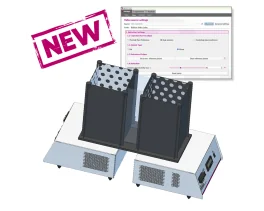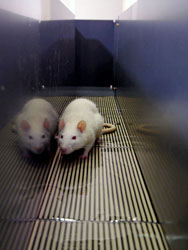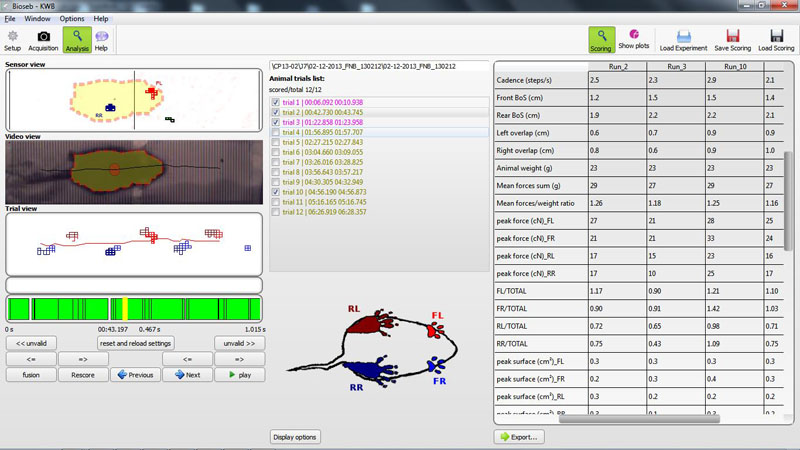
The Contextual Kits for T2CT have been designed to enhance thermal place preference studies...

The Contextual Kits for T2CT have been designed to enhance thermal place preference studies...
Discover our products
An easy way to objectively quantify the muscular strength of mice and rats, and to assess the...
Discover our products
The BIOSEB Spontaneous Activity Wheel offers an effective solution for quantifying rodent...
Discover our products
The BIOSEB Spontaneous Activity Wheel is an easy way to quantify rodent voluntary activity in...
Discover our products
The uncomplicated way to monitor rodent activity over several days from their home cage...
Discover our products
These small animal treadmills are used for forced exercise training and accurate testing of...
Discover our products
For testing animal's thermal sensitivity to pain resulting from exposure to heat or cold: the...
Discover our products
An operator independent test to study pain thresholds in rodents (mouse and rat) by assessing...
Discover our products
New and improved! The operator-independent Thermal Gradient Test used to show favorite...
Discover our products
The Contextual Kits for T2CT have been designed to enhance thermal place preference studies...
Discover our products
The advanced version of our Dynamic Weight Bearing Test for rodents (rats and mice) allows for...
Discover our products
An easy and non pain-inducing solution for assessing the level of discomfort (incapacitance) in...
Discover our products
A unique device that provides automated measurement of weight bearing and force distribution...
Discover our products![Dynamic Weight Bearing 2.0 – Postural Module [Add-on]](https://bioseb.com/733-home_default/dynamic-weight-bearing-20-add-on-postural-module.jpg)
Expand Your Analysis with Advanced Postural and Locomotor Calculations BIOSEB’s renowned...
Discover our products
A quick solution to determine the mechanical sensitivity threshold in rodents (mice and rats)....
Discover our products
As an electronic version of the classical Von Frey Filaments esthesiometer (or aesthesiometer),...
Discover our products
New ROBUST and modular cages to gently hold rodents (rats or mice) during nociceptive and...
Discover our products
An economical and versatile solution for when flexible quantitative sensory testing (QST) is...
Discover our products
Dedicated to small animals, like mice and rats, Smalgo is a pressure-based analgesimeter...
Discover our products
Bioseb's version 5 of the Tail Suspension Test system, based on both strain sensors and video...
Discover our products
NEW ! A complete (hardware + software), dedicated and automated solution for the Elevated Plus...
Discover our products
A unique setup for the automation of the Open Field test for rats and mice : 3D-camera based...
Discover our products
Open-field test - ARENA ONLY - used to evaluate of animal's basal activity and its evolution for...
Discover our products
The new Forced Swimming Test system from Bioseb uses a dual approach: Combining a double input...
Discover our products
A brand new innovative setup for the automation of the Novel Object Recognition Test : 3D-camera...
Discover our products
Open-field test - ARENA ONLY - used to evaluate of animal's basal activity and its evolution for...
Discover our products
An entirely modular experimental enclosure designed to conduct operant conditioning procedures...
Discover our products
A standard experimental chamber for automated or manual assessment of conditioned place...
Discover our products
Real-Time Physiological Monitoring for Small Animals – Wireless & Non-Invasive The Bioseb...
Discover our products
The ETH-401 is a bridge amplifier for various transducers that provides four channels of...
Discover our products
The IX-118 is a fast 100 Khz, high-resolution data acquisition system suitable for most data...
Discover our products
The ETH-256 is a 2 channels high performance, general-purpose life science research amplifier,...
Discover our products
Full-featured multi-channel stimulator for neuromuscular stimulation
Discover our products
Discover BIO-FOODIS, the next generation solution for understanding animal feeding behavior with...
Discover our products
The OXYLET system - Physiocage is a modular system allowing the integration of respiratory...
Discover our products
Innovative and appropriate equipment for measuring food/liquid consumption and correlated motor...
Discover our products
An economical, high performance Oxygen and Carbon Dioxide Analyzer with sampling rates fast...
Discover our productsA unique device that provides automated measurement of weight bearing and force distribution over time during voluntary gait. Synchronized video tracking and force transducers measure gait dynamics, for a voluntary multi-step sequence as a subject (rat or mouse) traverses a corridor to its home cage.
KWB is an innovative instrument for your research on analgesia, nociception and neuroscience, especially suited for work on Parkinson's disease, arthritis, spinal cord injury and more.
![]()
![]()
![]() Presentation
Presentation

BIOSEB Kinetic Weight Bearing (KWB), like the BIOSEB Dynamic Weight Bearing (DWB) instrument represents a giant leap forward in incapacitance testing where weight bearing on each paw is continuously and independently measured and analyzed automatically. The KWB instrument provides information on applied weight as well as the speed and acceleration of each paw during a voluntary walking sequence.. These data provide information about coordination and gait through paw to paw and step to step comparisons.
Gait analysis has been extensively used in phenotyping of CNS diseases such as cerebral ischemia, neurodegenerative diseases, spinal cord injury models and some pain models like neurotrauma (Nerve Crush, SNI). BIOSEB has extended existing gait analysis by including the measurement of the force applied by each individual paw to the floor the animal is walking upon.![]() Operating principle
Operating principle
The subject initiates a voluntary walking sequence from a starting chamber, across a corridor, to its home cage. The supplied KWB software synchronizes the aerial video capture with the pressure applied by each paw in real time using an array of 4,000 (mouse) or 6,000 (rat) sensors during the walking sequence. Automated parameter analysis for each paw such as Maximum Force (mN), Mass Velocity (N/s), and Maximum surface area (cm2)are reported along with gait dynamics such speed, cadence, overlaps, and step patterns are all compared across paws and steps and statistically processed.
BIOSEB has demonstrated that the rising time to the maximum force of each animal step differs across animal models. The KWB is able to compare the path of the animal's 'Geometric Center of Gravity' with the actual 'Weighted Center of Gravity', and show significant differences. Changes in weight distribution from left to right, front to back and contra-lateral compensation are easily measured, thus providing useful information for your research work on nociception and analgesia.

![]() Supplied with
Supplied with
• Elevated stand
• Mouse and Rat home cages
• Sensors mat x 2 + interfaces
• HD USB camera
• KWB Software license: allows you to install the full software on 1 computer, and the software in 'replay' mode on as many computers as needed!
Data sheet
Number of publications:
An easy way to objectively quantify the muscular strength of mice and rats, and to assess the effect of drugs, toxins,...
The BIOSEB Spontaneous Activity Wheel offers an effective solution for...
The BIOSEB Spontaneous Activity Wheel is an easy way to quantify rodent voluntary activity in their home cage environment....
check_circle
check_circle